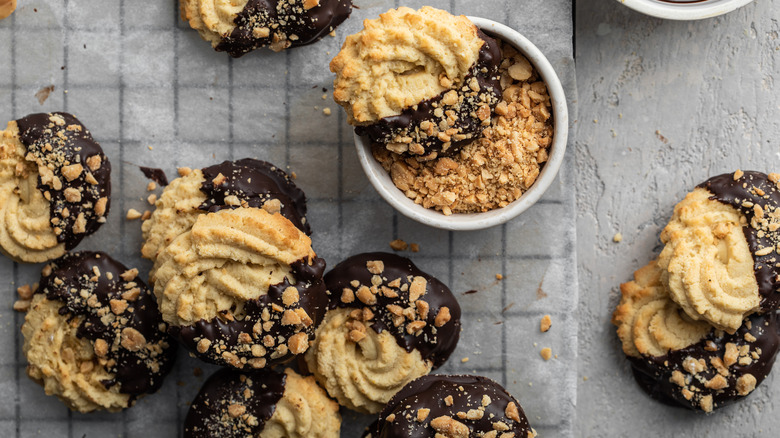What Makes A Butter Cookie Different From Other Cookies
We may receive a commission on purchases made from links.
Most of us designate types of cookies by flavors and mix-ins like chocolate chips or peanut butter. However, butter cookies stand out from other cookies in a completely different way. We interviewed Jerrelle Guy, author of James Beard Award-nominated cookbook, "Black Girl Baking," and the creator of The Dinner Ritual, a newsletter exploring the intersection of cooking and spirituality, for her expertise on butter cookies.
While butter cookies share many of the same foundational ingredients as other types of cookies, like butter, flour and sugar, the difference lies more in the proportions of ingredients. According to Guy, "butter cookies are known for their high butter-to-flour ratio and minimal use of leavening agents to create a tender, crisp texture with a rich, clean buttery flavor." Our recipe for old-fashioned butter cookies, for example, uses a ratio of one part sugar, two parts butter and three parts flour. Furthermore, there's no leavening agents whatsoever; our recipe uses eggs, but only the yolks for richness and binding.
"Unlike drop cookies (e.g., chocolate chip, oatmeal cookies), which often include eggs, baking soda, or mix-ins, butter cookies are more about simplicity and precision," she explains. "Their flavor comes almost entirely from the quality of the butter and vanilla, and they rely on precise ratios for structure and mouthfeel." A higher fat ratio equates to a harder, crunchier cookie, and in the case of butter cookies, butter plays the role of texture and flavor agent. The vanilla brings an aromatic complement to butter's richness.
Can you convert any cookie recipe to a butter cookie?
If you want to impart that same buttery richness and delightfully crumbly texture to another type of cookie, it might not be as simple as switching the butter and flour ratio. "'Butter cookies' technically call for a specific ratio of fat, flour, and sugar — with little to no leavening or liquid," Guy explains. "So recipes that include eggs, brown sugar, or high-moisture ingredients couldn't be converted."
That said, you can adjust the ratios of the ingredients of the cookie recipe in question without omitting ingredients completely. In fact, we think that the key to a crunchier cookie is to increase the amount of fat, so if you increase the amount of butter in your chocolate chip cookie recipe, for example, you're killing two birds with one stone by, as chef Guy says, "creat[ing] a firmer, more butter-cookie-like profile with a butter-forward flavor."
You can also try swapping moist ingredients out for drier counterparts, like swapping a moist brown sugar for the drier white sugar. From the other end of the spectrum, you can add flavors to your butter cookies and bring them into a gooey, chewy realm like we do with this recipe for lemon gooey butter cookies. If you still want the classic texture, flavor butter cookies by swapping vanilla extract for almond extract and top the cookie with a maraschino cherry before baking. Dip butter cookies in dark chocolate.

